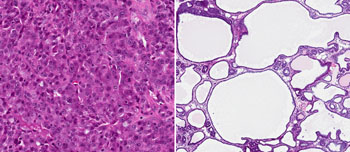Loss of Long Noncoding RNA Inhibits Breast Tumor Metastasis in Mouse Model
By LabMedica International staff writers
Posted on 05 Jan 2016
Blocking the activity of a single long noncoding RNA (lncRNA) in malignant breast cancer mouse models transformed aggressive cancers into slow growing cyst-like tumors and reversed the metastatic process by up to 70%.Posted on 05 Jan 2016
Long noncoding RNAs (lncRNAs) are non-protein coding transcripts longer than 200 nucleotides. This somewhat arbitrary limit distinguishes lncRNAs from small regulatory RNAs such as microRNAs (miRNAs), short interfering RNAs (siRNAs), Piwi-interacting RNAs (piRNAs), small nucleolar RNAs (snoRNAs), and other short RNAs. LncRNAs have been found to be involved in numerous biological roles including imprinting, epigenetic gene regulation, cell cycle and apoptosis, and metastasis and prognosis in solid tumors. Most lncRNAs are expressed only in a few cells rather than whole tissues, or they are expressed at very low levels, making them difficult to study.

Image: Left panel: Micrograph of an undifferentiated breast tumor - densely packed with cancerous cells and with a high potential to spread. Right panel: Differentiated tumor following anti-Malat1 ASO treatment with cyst-like cells filled with fluid containing, among other things, milk proteins. Treated tumors were comparatively static with reduced metastatic activity (Photo courtesy of Spector Laboratory, Cold Spring Harbor Laboratory).
Malat1 (metastasis-associated lung adenocarcinoma transcript 1) is among the most abundant lncRNAs whose expression is altered in numerous cancers. Investigators at Cold Spring Harbor Laboratory (NY, USA) examined the role of Malat1 in cancer by either knocking it out—genetically engineering animals to lack the Malat1 gene—or with specific antisense oligonucleotides (ASO) that blocked Malat1 activity despite the presence of the active gene.
They reported in the December 23, 2015, online edition of the journal Genes & Development that genetic loss or systemic knockdown of Malat1 using antisense oligonucleotides in the MMTV (mouse mammary tumor virus)-PyMT mouse mammary carcinoma model resulted in slower tumor growth accompanied by significant differentiation into cystic tumors and a reduction in metastasis by up to about 70%. The ASOs were developed in collaboration with the biotechnology firm Ionis Pharmaceuticals (Carlsbad, CA, USA).
Malat1 loss resulted in a reduction of branching morphogenesis in MMTV-PyMT- and Her2/neu-amplified tumor organoids, increased cell adhesion, and loss of migration. At the molecular level, Malat1 knockdown caused alterations in gene expression and changes in splicing patterns of genes involved in differentiation and pro-tumorigenic signaling pathways.
"We got an amazing result," said senior author Dr. David L. Spector, head of the gene regulation and cell proliferation program at Cold Spring Harbor Laboratory. "By removing Malat1—this one, single long noncoding RNA—we made a dramatic impact on the primary breast tumors in these mice. The tumors took on a wholly new character. Aggressive breast cancer tumors differentiated and took on cyst-like characteristics. They filled with fluid, which contained various proteins including milk proteins, demonstrating that some of the tumor cells had differentiated. Just as important, in these mice lacking Malat1, there was nearly no metastasis."
"We are very pleased and excited by this result," said Dr. Spector, "because it suggests that these metastatic tumors have a dependency on Malat1—they cannot thrive without it. And very importantly, targeting Malat1 should not have a deleterious effect on any normal cells. At least in this mouse model normal, noncancerous cells do not seem to care a bit if they have Malat1 or not. Only the cancer cells seem to require it."
Related Links:
Cold Spring Harbor Laboratory
Ionis Pharmaceuticals














